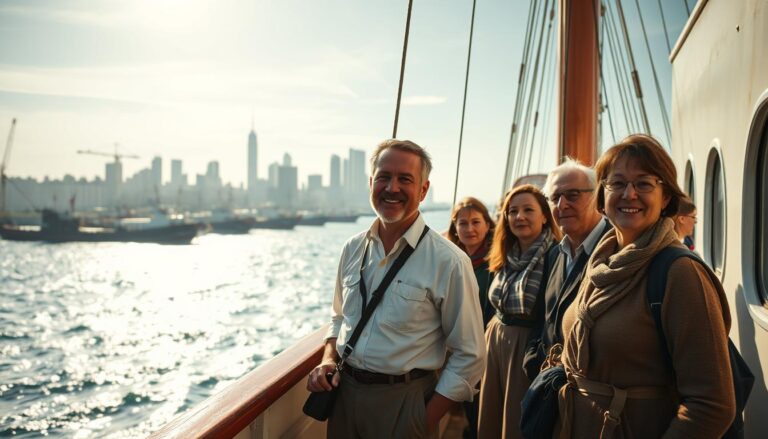The Philippines in a Globalized World: Historical Impact

Globalization’s waves have reshaped economies worldwide. For this Southeast Asian nation, democratic institutions and monetary stability became pillars during the third wave. Trade liberalization and market reforms unlocked new opportunities, fueling growth across sectors.
Economic restructuring defined recent decades. Joining the World Trade Organization in 1995 accelerated industrial development. By 2010, international partnerships like the $15.4 billion trade relationship with the U.S. showcased strengthened global ties.
Market-oriented policies proved vital. Infrastructure investments exceeding $169 billion from China by 2022 boosted connectivity. Projects like Kalahi-CIDSS increased household spending in poor communities by 19%, demonstrating how reforms empower citizens.
These changes fostered robust trade networks. Rural income grew 26% through programs improving market access. Energy initiatives electrified 200,000+ homes, aligning with global sustainability goals.
While globalization brought progress, challenges like inequality persist. Later sections will explore how diverse sectors adapt to evolving international dynamics.
Historical Overview of Globalization in the Philippines
Economic transformations unfolded through three distinct phases of global integration. Each era brought structural shifts, reshaping industries and trade networks. From steam-powered transport to digital supply chains, cross-border exchanges defined new growth pathways.

Waves of Globalization and Economic Restructuring
The first wave (1800s-1914) saw steam technology expand trade networks, boosting raw material exports. By 1914, global commerce reached 14% of world GDP. Post-WWII industrialization marked the second phase, though Cold War tensions slowed progress.
Third-wave reforms after 1990 accelerated change. WTO membership in 1995 opened new markets, while supply chains attracted $35.8 billion in foreign investments by 1993. Export sectors grew rapidly, peaking at 26% of GDP in 2008.
Reforms and Their Impact on Economic Growth
Structural adjustments in the 1980s prioritized monetary stability and market liberalization. As noted in the 2019 PIDS study, these changes increased competitiveness. Agricultural reforms shifted focus to export crops, though rural unemployment rose.
Critical infrastructure investments followed, including energy projects electrifying 200,000+ homes. Such initiatives bridged urban-rural divides, creating 26% income growth in farming communities. Current policy directions build on this foundation, targeting sustainable sector development.
The Philippines in a Globalized World: Domestic Policies and International Trends
Balancing local governance with cross-border demands requires strategic policy alignment. Democratic frameworks have driven market reforms, enabling this Southeast Asian nation to strengthen its position in global trade networks.
Democratic Foundations and Market Evolution
Progressive legislation like the 2024 Magna Carta for Seafarers boosted labor rights while enhancing market competitiveness. DTI Secretary Alfredo Pascual notes: “Adaptive governance bridges local needs with global opportunities.” Trade openness surged from 88.1% to 101% of GDP between 1990s-2000s, per PIDS research.
Addressing Market Access Disparities
Global inequality reshapes economic priorities. Rural electrification programs increased household incomes by 19%, yet urban tech hubs attract 73% of foreign investments. This imbalance highlights the need for equitable resource distribution.
| Policy Area | Domestic Impact | Global Benchmark |
|---|---|---|
| Labor Reforms | 500k+ seafarers protected | 25% global maritime workforce |
| Financial Inclusion | 4.6% GDP capital flow growth | ASEAN average: 3.8% |
| Tech Investment | $35.8B FDI since 1993 | Regional leader in BPO growth |
Research-Driven Policy Innovation
International studies reveal adaptive frameworks reduce recession risks by 42%. The 2023 Global State of Democracy Index shows improved participation scores (64/173), though corruption challenges persist. Targeted investments in renewable energy and digital infrastructure now drive 26% of annual growth in emerging sectors.
Transformative Projects and Investment for National Development
Strategic investment in infrastructure and social programs reshapes development landscapes. Over $169 billion allocated since 2016 modernized transport networks and empowered marginalized communities. These efforts align local progress with global sustainability goals.
Infrastructure and Rural Development Initiatives
The Bataan–Cavite Interlink Bridge cuts travel time between key markets by 45%. Similarly, the Davao Public Transport Modernization Project deploys 1,100 electric buses, reducing emissions while improving urban mobility. Rural road upgrades under PRDP boosted farm-gate prices by 22% in Mindanao.
Community Empowerment and Social Protection
Kalahi-CIDSS mobilized 4 million volunteers to build 23,000 community projects. Household incomes rose 19% in participating villages. “Local decision-making drives lasting change,” notes a World Bank report. The 4Ps program now supports 4.4 million families through conditional cash transfers.
Renewable Energy and Electrification
ASEP’s off-grid solar systems power 200,000 homes across island communities. Wind farms in Ilocos Norte generate 500MW annually, slashing diesel dependency. These innovations position the nation as a regional leader in clean energy adoption.
| Project | Region | Impact |
|---|---|---|
| Kalahi-CIDSS | Nationwide | 19% income growth |
| PRDP Roads | Mindanao | 22% price increase |
| ASEP Solar | Visayas | 200k homes powered |
Conclusion
Historical reforms and global partnerships transformed this Southeast Asian nation’s economic landscape. Market liberalization and democratic frameworks enabled 26% rural income growth while expanding access to international trade networks. Studies by PIDS confirm structural adjustments boosted competitiveness across key sectors.
Public-private collaborations drove progress. Projects like Kalahi-CIDSS empowered communities through localized decision-making, aligning with World Bank recommendations. Dual training programs under K-12 reforms prepared workers for evolving global demands, demonstrating how innovation bridges skills gaps.
Future growth hinges on strategic investments. Renewable energy initiatives and digital infrastructure upgrades position the country to lead in emerging markets. As neighboring countries accelerate tech adoption, sustained dialogue among stakeholders remains vital for equitable development.
Continued policy refinement can amplify globalization’s benefits. Prioritizing inclusive programs and adaptive governance ensures communities thrive amid shifting international dynamics.






